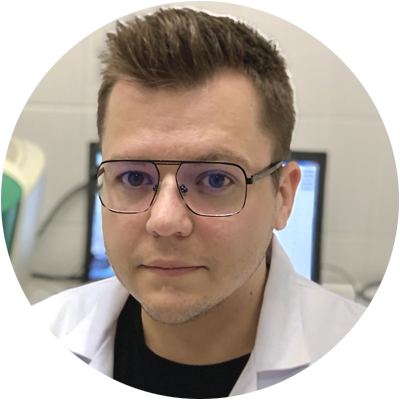NSC GRANTS FOR MUL YOUNG RESEARCHERS
MINIATURA 5 call laureates have been made public. The list of 130 laureates, whose projects received funds from National Science Centre, includes ten representatives of our university.
Congratulations! We wish you further success in your scientific career!
The aim of MINIATURA call is to finance research activities conducted for the purpose of future research project to be submitted under an NSC call or other domestic and international calls for proposals. The fifth edition of MINIATURA offers grants from PLN 5,000 up to 50,000 for activities to be carried over a period of up to 12 months
| Title | Type of research activity | Faculty | The researcher | Grant (PLN) | |
| 1. | Disturbances in the interaction between vascular endothelial cells and neoplastic cells caused by anabolic steroid-induced endothelial dysfunction | preliminary/pilot study | Faculty of Health Sciences | Marcin Popielarski MD PhD | 45,100 |
| 2. | The assessment of WNT/β-catenin pathway activiy in vemurafenib or trametinib-resistant melanoma cell lines | preliminary/pilot study | Faculty of Medicine | Anna Gajos-Michniewicz MD PhD | 49,995 |
| 3. | The search for genes responsible for naive lymphocytes polarisation to autoreactive CD49d+CD154+ sub-population in multiple sclerosis | preliminary/pilot study | Faculty of Medicine | Magdalena Anna Namiecińska MD PhD | 49,830 |
| 4. | Post-translational histone modifications accountable for reprogramming of maturing oligodendrocyte precursors into antigen-presenting cells | preliminary/pilot study | Faculty of Medicine | Paweł Piątek MD PhD | 49,500 |
| 5. | Design, synthesis and analysis of the biological activity of neuroprotective peptides | preliminary/pilot study | Faculty of Medicine | Renata Perlikowska MD PhD | 49,819 |
| 6. | Radiomic methods in research into neoplastic diseases (research internship) | research internship | Faculty of Medicine | Urszula Maria Smyczyńska PhD Eng. | 34,100 |
| 7. | The assessment of the impact of selected human gut microbiota metabolites on the gliotransmitters release in the model of human astrocytes cultures | preliminary/pilot study | Faculty of Medicine | Michał Seweryn Karbownik MD PhD | 40,700 |
| 8. | Do fungal antigens affect the expression of selected pattern recognition receptors on human peripheral blood mononuclear cells (PBMCs)? | preliminary/pilot study | Faculty of Health Sciences | Elżbieta Magdalena Kozłowska MD PhD | 49,335 |
| 9. | The impact of Omega-3 fatty acids on TREM2 expression and activity in microglia. | preliminary/pilot study | Faculty of Medicine | Emilia Zgórzyńska MD PhD | 49,940 |
| 10. | Anti-EGFRvIII single-chain variable fragment (scFv) modeling as a method to optimise new therapeutic approaches, including CAR-T therapy, in glioblastoma multiforme | preliminary/pilot study | Faculty of Medicine | Tadeusz Witold Strózik PhD Eng. | 49,999 |
Marcin Popielarski MD PhD (Department of Cell Biology and Proteomics)
 Tytuł projektu: Zaburzenia w interakcji pomiędzy komórkami śródbłonka naczyniowego i komórkami nowotworowymi spowodowane przez dysfunkcję śródbłonka naczyniowego wywołaną działaniem sterydów anabolicznych
Tytuł projektu: Zaburzenia w interakcji pomiędzy komórkami śródbłonka naczyniowego i komórkami nowotworowymi spowodowane przez dysfunkcję śródbłonka naczyniowego wywołaną działaniem sterydów anabolicznych
Sterydy anaboliczno (AAS) to grupa hormonów steroidowych obejmująca testosteron oraz jego syntetyczne modyfikacje. Są stosowane w ramach niedozwolonego dopingu w sporcie ze względu na ich anaboliczne właściwości powodujące wzrost muskulatury, wytrzymałości oraz siły fizycznej. Pomimo ograniczeń dostępności AAS ich użycie w ciągu ostatnich lat wzrosło wśród osób ćwiczących rekreacyjnie, zwłaszcza wśród kobiet. Długotrwałe stosowanie AAS prowadzi do niewydolności wątroby oraz układu sercowo-naczyniowego, zahamowania produkcji własnej testosteronu, nowotworów prostaty, wirylizacji u kobiet, a nawet prób samobójczych.
Hipotez badawcza zakłada, że AAS wywołują dysfunkcję śródbłonka naczyniowego, co prowadzi do zaburzenia interakcji pomiędzy śródbłonkiem, a innymi komórkami oraz przyczynia się do nasilenia zjawiska metastazy. W ramach badań przeprowadzona zostanie ocena poziomu adhezji komórek nowotworowych (zależnych od androgenów, zależnych od estrogenów i niezależnych od hormonów płciowych) do śródbłonka naczyniowego, a także ocena migracji inwazyjnych komórek nowotworowych przez monowarstwę śródbłonka w obecności AAS.
Anna Gajos-Michniewicz MD PhD (Department of Molecular Biology of Cancers)
 The project title: The assessment of WNT/β-catenin pathway activity in vemurafenib or trametinib-resistant melanoma cell lines
The project title: The assessment of WNT/β-catenin pathway activity in vemurafenib or trametinib-resistant melanoma cell lines
Melanoma is the cancer which is a significant problem for modern oncology as a global dynamic increase in its incidence is recorded and the age of sufferers is found to be relatively young. Therapies with the use of small-molecule mutated BRAF and MEK1/2 kinase inhibitors have revolutionised the treatment to melanoma patients, however, what still poses a huge challenge is a resistance to the treatment which appears relatively quickly. Therefore, new proteins are being searched for as an additional therapeutic goal.
An increased activity of the canonical WNT signalling pathway is observed in a variety of cancers including melanoma. The outcomes of the research conducted at the Department of Molecular Biology of Cancers indicate an elevated level of active β-catenin in vemurafenib or trametinib-resistant cells when compared to the cells sensitive to the medication. This allows for the assumption that enhanced activity of the canonical WNT pathway is characteristic of the resistant lines. Thus, it seems reasonable to investigate the level and/or the activity of the proteins that are involved in the regulation of the canonical WNT signalling pathway and to evaluate the activity of TCF / LEF transcription factors in the resistant cells.
Magdalena Anna Namiecińska MD PhD (Department of Immunogenetics)
 The project title: The search for genes responsible for naive lymphocytes polarisation to autoreactive CD49d+CD154+ sub-population in sclerosis multiplex
The project title: The search for genes responsible for naive lymphocytes polarisation to autoreactive CD49d+CD154+ sub-population in sclerosis multiplex
The project will identify the genes which are involved in the polarisation of the lymphocyte subpopulation responsible for impaired demyelination in sclerosis multiplex (SM). This autoimmunological disease of the central nervous system is manifested by a chronic inflammation and demyelination related to i.a. T and B lymphocytes disfunction. The disease development is caused by two processes: loss of axons and progressing demyelination. Our earlier research revealed that what is responsible for the impaired demyelination and increasingly more severe symptoms at each relapse is the autoreactive, myelin-specific subpopulation of CD49d+CD154+ lymphocytes. The selected genes edition can inhibit the polarisation of ‘pathological’ lymphocyte subpopulation before it enters blood-brain barrier and can be a turning point in the targeted, highly-specific therapy in SM treatment.
Paweł Piątek MD PhD (Department of Immunogenetics)
 The project title: Post-translational histone modifications accountable for reprogramming of maturing oligodendrocyte precursors into antigen-presenting cells
The project title: Post-translational histone modifications accountable for reprogramming of maturing oligodendrocyte precursors into antigen-presenting cells
The project is closely related to our earlier research into myelin-specific population of CD49d+CD154+ lymphocytes which accounts for the development and relapse of sclerosis multiplex and maturing oligodendrocyte precursors (myelin-producing) as antigen-presenting cells. Post-translational histone modifications play a key role in gene transcription control.
The aim of this study is to determine which of the post-translational histone modifications are responsible for reprogramming of the maturing oligodendrocyte precursors into antigen-presenting cells. The most common modifications have been selected for the study including the ones behind the gene transcription in antigen-presenting cells, monocytes or B lymphocytes among others. Dot blotting shall be used to identify the histone modifications and the obtained results will be used to continue more profound ChIP-Seq analyses of maturing oligodendrocyte precursors after interaction with specific CD49d+CD154+ lymphocytes.
Renata Perlikowska MD PhD (Department of Biomolecular Chemistry)
 The project title: Design, synthesis and analysis of the biological activity of neuroprotective peptides
The project title: Design, synthesis and analysis of the biological activity of neuroprotective peptides
The main aim of this project is to design, synthesise and analyse the neuroprotective activity of short peptides whose structure will be based on the sequence of the well-investigated opioid peptides: endomorphins and rubiscolin. The evaluation of the neuroprotective activity with the use of human neuroblastoma cell line (SH-SY5Y) will be carried out in the experimental model of oxidative stress-induced or glucocorticosteroid-induced damage imitating pathological symptoms of Parkinson’s disease (PD) or depression.
The outcomes made available so far confirm that opioid peptides promote neuronal survival in the nervous system development and they affect neuronal proliferation and migration. What’s more, they are considered to be neurotrophic factors. It therefore seems advisable to seek pharmacological substances and therapeutic strategies that inhibit or modulate the process of neurodegeneration.
Emilia Zgórzyńska MD PhD (Department of Intercellular Interactions, University Laboratory of Sensory Functions)
The project title: The impact of Omega-3 fatty acids on TREM2 expression and activity in microglia.
Epidemiological data show that dementia is most commonly caused by the Alzheimer’s Disease, when neuronal degeneration occurs as a result of extracellular amyloid deposits formation and hyperphosphorylated tau protein aggregation in neurons. One of the causes of amyloidogenesis and progressive neurodegeneration is chronic activation of microglia and astrocytes which are transformed into pro-inflammatory phenotype. The available reports on beneficial impact of polyunsaturated fatty acids ω-3 (ω-3PUFA) in age-related neurological diseases together with the outcomes of my research into ω-3 PUFA activity in glial cells indicate an inhibitory function of ω-3 PUFA in pro-inflammatory response and provide enough ground to continue the relevant analysis. The aim of my current study is to investigate the impact of EPA and DHA on the expression and activity of membrane microglia protein TREM2 which is activated in the inflammatory response. The obtained results will improve our understanding of molecular mechanisms of microglia activation and will allow for the design of therapies with natural ingredients which can diminish the development of pathological aggregates which are the causes of neurodegeneration.
Witold Strózik PhD Eng. (Department of Molecular Biology)
 The project title: Anti-EGFRvIII single-chain variable fragment (scFv) modelling as a method to optimise new therapeutic approaches, including CAR-T therapy, in glioblastoma multiforme
The project title: Anti-EGFRvIII single-chain variable fragment (scFv) modelling as a method to optimise new therapeutic approaches, including CAR-T therapy, in glioblastoma multiforme
The aim of the project is to design and assess the efficiency of anti-EGFRvIII single-chain variable fragment (scFv). Mutations in the extracellular domain of the epidermal growth factor receptor (EGFRwt) are involved in the development of glioblastoma (GB), the most aggressive form of primary tumour of the central nervous system. What is of particular significance in GB tumourigenesis , and the most common EGFR mutation in GB, is a deletion mutant known as variant III (EGFRvIII), which occurs in approx. 30% of cases.
To date, several antibodies to EGFRvIII have been developed, nevertheless, most of them have low affinity or show marked cross-reactivity with normal EGFRwt. The project involves the attempt to develop specific anti-EGFRvIII scFv of a high affinity. The sequence of the fragment will further serve the purpose of designing T lymphocytes with chimeric antigen receptor (CAR-T). The obtained results will also be of value in the understanding of extracellular structure of EGFRvIII and its relationship with the constitutive activation of this receptor as well as the activity mechanisms of the mutated protein.
 Michał Karbownik MD PhD (Department of Pharmacology and Toxicology
Michał Karbownik MD PhD (Department of Pharmacology and Toxicology
The project title: The assessment of the impact of selected human gut microbiota metabolites on the gliotransmitters release in the model of human astrocytes cultures
Recent research into gut microbiota has revolutionised our understanding of the process of human brain development and its functioning in health and in disease. However, despite the progress in molecular, preclinical and clinical studies, it is yet to be clarified how micro-organisms affect our brain.
One of potential mechanisms includes a release of metabolites which, having reached the brain, interact with the receptors of the glial cells. Cerebral glia cells do not only have a macrostructural function but together with neurons they create synaptic connections. The secretion of specific gliotransmitters maintains the synaptic homeostasis and contributes to neuroplasticity. It seems that so far there has been no research conducted into the impact of gut microbiota metabolites on gliotransmission. This research project is supposed to fill in this gap in our knowledge and contribute to the development of new therapies in neuropsychiatry.
 Urszula Smyczyńska PhD Eng. (Deprtment of Biostatistics and Translational Medicine)
Urszula Smyczyńska PhD Eng. (Deprtment of Biostatistics and Translational Medicine)
The project title: Radiomic methods in research into neoplastic diseases
The project involves a 10-week research internship in Dana-Farber Cancer Institute (Harvard Medical School). The aim of the project is to expand the knowledge and acquire skills in radiomics, a scientific discipline which includes advanced techniques of medical imaging analysis e.g. computer tomography in patients with neoplastic diseases. The competences acquired during the internship at the leading research institute with extensive experience in radiomic research will be applied in the implementation of one’s own project concerning lung cancer.
The research project also aims at searching for new solutions between radiomic characteristics (the features of the tumour ‘appearance’ in medical imaging) and molecular features of lung cancers. The information obtained in such imaging will enable more precise and less invasive diagnostics in patients with lung cancer in the future.
 Elżbieta Kozłowska MD PhD (Department of Microbiology and Experimental Immunology)
Elżbieta Kozłowska MD PhD (Department of Microbiology and Experimental Immunology)
The project title: Do fungal antigens affect the expression of selected pattern recognition receptors on human peripheral blood mononuclear cells (PBMCs)?
It has already been demonstrated that fungi constitute a significant component of human microbiota (mycobiome) and by influence on various cells they can regulate many physiological and pathological conditions, in particular they can modulate the activity of the cells engaged in immunological and inflammatory processes. The available data show that changes in mycobiome composition may lead to the development or increased severity of many diseases, including inflammatory bowel diseases, allergic diseases of the respiratory system, chronic obtrusive pulmonary disease, sarcoidosis, and some autoimmunological diseases.
The funds obtained in MINIATURA 5 call for proposals are meant to be used to determine whether the components of cellular membrane of the fungi can regulate the expression of selected molecules of PRR group on human peripheral blood mononuclear cells (PBMCs). The project involves the assessment of mannan and β-(1,3)-glucans impact on selected cells.
Functionality of given receptors will also be investigated with (or without) simultaneous application of the inhibitors of intracellular signalling. Along with the researcher’s earlier studies in this issue, the obtained outcomes will initiate a large scientific project on the impact assessment of fungal antigens on the phenotype and activity of various subpopulations of immunocompetent cells which are the components of PBMC.








